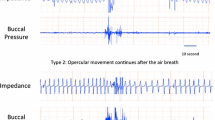Summary
ThepO2 in the hemolymph of the decapod crustaceanAstacus leptodactylus was measured continuously with micro O2 electrodes. PostbranchialpO2, heart rate and ventilation rate were simultaneously recorded. PrebranchialpO2 was measured in a separate series of experiments. Crayfish acclimated for six weeks to warm (20 °C) and cold (10 °C) conditions were studied.
-
1.
Postbranchial bloodpO2 was measured in the pericardium. Typical values for warm-acclimated animals fell in the range 23–35 Torr, with a mean of 28.3 Torr, and those for cold-acclimated animals were 17–30 Torr, with a mean of 24.4 Torr. PrebranchialpO2 was measured in the meropodites of the 8th thoracopod. VenouspO2 levels ranged from 7–13 Torr, mean 9.4 Torr (warm-acclimated), and 6–9 Torr, mean 6.8 Torr (cold-acclimated).
-
2.
pO2 values of resting, restrained animals were variable and fluctuations occurred in both the pre- and the postbranchial levels. Fluctuations were either small (1–5 Torr) or large (10–70 Torr).
-
3.
PostbranchialpO2 correlated with fluctuations in the ventilation and heart rates. ArterialpO2 rose when the ventilation rate was increased, with a delay of about 10 s in warm-acclimated and 20 s in cold-acclimated animals, respectively. Along with increasingp aO2 an increase of the heart rate was established.
-
4.
In resting animals, there is no a-v pH-difference. Cell-free hemolymph, taken from the pericardium or the meropodites, had a pH of 7.48 or 7.47, respectively, in warm-acclimated animals and 7.94 or 7.97 in cold-acclimated animals. Under these conditions the hemocyanin was 99% saturated in the artial blood and 45% in venous (warm-acclimated). Corresponding values in cold-acclimated crayfish were 98% and 61%, respectively.
-
5.
TheP 50 of the hemocyanin in undiluted hemolymph was 10 Torr at 20 °C and pH 7.42, and 6.2 Torr at 10 °C and pH 7.92. The hemocyanin showed a weak Bohr effect (ΔlogP 50/ΔpH=−0.19 in warm-acclimated, and −0.20 in cold-acclimated animals). The pH range of the Bohr effect fell into the in vivo pH range in each group and thus differed by 0.5 pH units between the two groups.
Similar content being viewed by others
Abbreviations
- p aO2 :
-
oxygen tension of postbranchial (arterial) blood
- p vO2 :
-
oxygen tension of prebranchial (venous) blood
- SaO2 :
-
%O2 saturation of postbranchial blood
- SvO2 :
-
%O2 saturation of prebranchial blood
- P 50 :
-
pO2 at half saturation of hemocyanin
References
Arudpragasam, K.D., Naylor, E.: Patterns of gill ventilation in some decapod Crustacea. J. Zool.150, 401–411 (1966)
Baumann, H.: Das Gefäßsystem vonAstacus fluviatilis (Potamobius astacus L.). Z. wiss. Zool.118, 246–312 (1919)
Baumgärtl, H., Lübbers, D.W.: Platinum needle electrode for polarographic measurement of oxygen and hydrogen. In: Oxygen supply (eds. M. Kessler, D.F. Bruley, L.C. Clark, D.W. Lübbers, I.A. Silver, J. Strauss), pp. 130–136. München-Berlin-Wien: Urban und Schwarzenberg 1973
Bonaventura, C., Sullivan, B., Bonaventura, J., Bourne, S.: CO binding by hemocyanins ofLimulus polyphemus, Busycon carica andCallinectes sapidus. Biochem.13, 4784–4789 (1974)
Dahl, F.: Krebstiere oder Crustacea. In: Die Tierwelt Deutschlands, pp. 67–68. Jena: Gustav Fischer 1928
Dauscher, H., Flindt, R.: Vergleichende Untersuchungen zur Herztätigkeit bei frei beweglichen dekapoden Krebsen (Astacus fluviatilis Fab.,Astacus leptodactylus Escholz undCambarus affinis Say). Z. vergl. Physiol.62, 291–300 (1969)
Faxon, W.: A revision of the Astacidae. Cambridge: Museum print 1885
Flindt, R., Kahrmann, E.G.: Oxygen-induced variations of heart rates in crayfish. Physiol. Zoöl.45, 119–124 (1972)
Florey, E.: Lehrbuch der Tierphysiologie. Stuttgart: Georg Thieme 1970
Hogben, L.T.: Some observations on the dissociation of haemocyanin by colorimetric method. J. exp. Biol.3, 225–238 (1926)
Howell, B.J., Rahn, H., Goodfellow, D., Herreid, C.: Acid-base regulation and temperature in selected invertebrates as a function of temperature. Amer. Zool.13, 557–563 (1973)
Hutchinson, G.E.: Oxygen in lake waters. In: A treatise on limnology, pp. 575–652. New York: John Wiley and Sons 1957
Johansen, K., Lenfant, C., Mecklenburg, A.T.: Respiration in the crab,Cancer magister. Z. vergl.Physiol.70, 1–19 (1970)
Loewe, R., Linzen, B.: Haemocyanins in spiders. II. Automatic recording of oxygen binding curves, and the effect of Mg++ on oxygen affinity, cooperativity, and subunit association ofCupiennius salei haemocyanin. J. comp. Physiol.98, 147–156 (1975)
Mangum, C.P., Weiland, A.L.: The function of haemocyanin in respiration of the blue crabCallinectes sapidus. J. exp. Zool.193, 257–264 (1975)
Naynert, M.: Untersuchungen zur Steuerung der Scaphognathitenbewegung bei decapoden Krebsen (Potamobius astacus Leach andAstacus leptodactylus Esch.). Zool. Jb. Physiol.79, 77–104 (1975)
Redmond, J.R.: The respiratory function of hemocyanin in Crustacea. J. cell. comp. Physiol.46, 209–248 (1955)
Saito, Y., Baumgärtl, H., Lübbers, D.W.: The RF sputtering technique as a method for manufacturing needle-shaped pH-microelectrodes. In: Ion and enzyme electrodes in biology and medicine (eds. M. Kessler, L.C. Clark, D.W. Lübbers, J.A. Silver, W. Simon), pp. 103–109. München-Berlin-Wien: Urban und Schwarzenberg 1976
Schwartzkopff, J.: Vergleichende Untersuchungen der Herzfrequenz bei Krebsen. Biol. Zbl.74, 480–497 (1955)
Author information
Authors and Affiliations
Rights and permissions
About this article
Cite this article
Angersbach, D., Decker, H. Oxygen transport in Crayfish blood: Effect of thermal acclimation, and short-term fluctuations related to ventilation and cardiac performance. J Comp Physiol B 123, 105–112 (1978). https://doi.org/10.1007/BF00687838
Accepted:
Issue Date:
DOI: https://doi.org/10.1007/BF00687838




